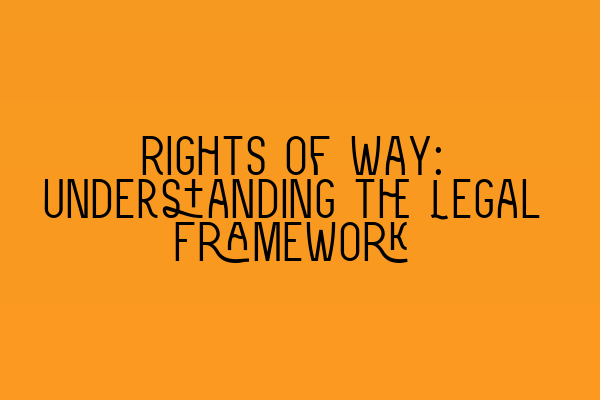Rights of Way: Understanding the Legal Framework
As a property owner or prospective buyer, it is essential to have a good understanding of the legal framework surrounding rights of way. Rights of way are legal rights that allow individuals to pass through or use someone else’s property for a specific purpose, typically for access to their own property or for transportation purposes.
In this article, we will explore the basics of rights of way and delve into the legal provisions and regulations that govern these rights. Whether you are a solicitor specializing in property law, a prospective homeowner, or simply an individual interested in understanding the intricacies of property law, this article will provide you with a comprehensive overview.
1. What are Rights of Way?
Rights of way are legal rights that grant a person or entity the privilege to pass through or use another person’s land for a particular purpose. These purposes can include walking, driving, or even laying utility lines. Rights of way can be created by various means, such as by a deed, by necessity, or by presumptive use.
2. Creation of Rights of Way
Rights of way can be created in several ways. One common method is through a formal agreement between the landowner and the user, known as a deed. This deed will contain specific terms and conditions regarding the rights of way, including its location, purpose, and any limitations.
Another way rights of way can be created is by necessity. This occurs when one property is landlocked, meaning it has no direct access to a public road. In such cases, the landowner may be granted a right of way over a neighboring property to access their land.
Rights of way can also be acquired through prescriptive use. If an individual has been using a particular route over another person’s land for an extended period without interruption, they may acquire a legal right to continue using that route.
3. Types of Rights of Way
There are several types of rights of way, each with their distinct characteristics and legal implications.
a. Public Rights of Way
Public rights of way are rights granted to the general public to access and use certain routes or areas. These rights are usually established by statute and can include footpaths, bridleways, and byways. Public rights of way are essential for maintaining access to public spaces and promoting recreational activities.
b. Private Rights of Way
Private rights of way, on the other hand, are specific to individuals or entities and are not available to the general public. These rights are typically granted in legal documents like title deeds and are specific to the purpose and location outlined in the agreement.
c. Easements
Easements are legal rights that allow a person to use another person’s land for a particular purpose. They can include rights of way, but they can also extend to other uses such as drainage or the installation of utility lines. Easements can be both public and private and can be created by express agreement or by implication based on the circumstances.
4. Legal Considerations for Rights of Way
When dealing with rights of way, both landowners and users need to be aware of their legal rights and responsibilities. Here are a few key considerations:
a. Maintenance and Repair: The responsibility for maintaining and repairing a right of way usually falls on the user unless otherwise specified in the legal agreement. It is crucial to understand these obligations to avoid disputes and ensure proper upkeep.
b. Obstructions: Landowners must not obstruct or interfere with rights of way granted to others. Restricting or interfering with a right of way without proper legal justification can result in legal action and potential liability.
c. Terminating or Modifying Rights of Way: Rights of way can be terminated or modified under certain circumstances. This can be done through mutual agreement, abandonment, or through legal action in some cases. It is advisable to seek legal advice when considering terminating or modifying an existing right of way.
5. Seeking Legal Advice
Given the complexities and potential legal implications of rights of way, it is strongly recommended to seek legal advice from a qualified property law solicitor. They can guide you through the legal process, help you understand your rights and obligations, and ensure that your interests are protected.
At SQE Property Law & Land Law, we have experienced solicitors specializing in property law who can provide you with the expert advice and assistance you need. Our team is well-versed in all aspects of rights of way and can help you navigate through any legal issues you may face.
To further enhance your understanding of property law and prepare for your SQE exams, we recommend exploring our related articles and courses:
– SQE 1 Practice Exam Questions
– SQE 1 Practice Mocks FLK1 FLK2
– SQE 2 Preparation Courses
– SQE 1 Preparation Courses
– SRA SQE Exam Dates
In conclusion, understanding the legal framework surrounding rights of way is essential for both property owners and users. By knowing your rights and responsibilities, seeking legal advice when needed, and staying informed about the relevant legislation, you can ensure a smooth and legally compliant experience regarding rights of way.
Remember, at SQE Property Law & Land Law, we are here to assist you with any property law matters or SQE exam preparations you may require. Contact our team today to schedule a consultation and take the first step towards a successful property transaction.
